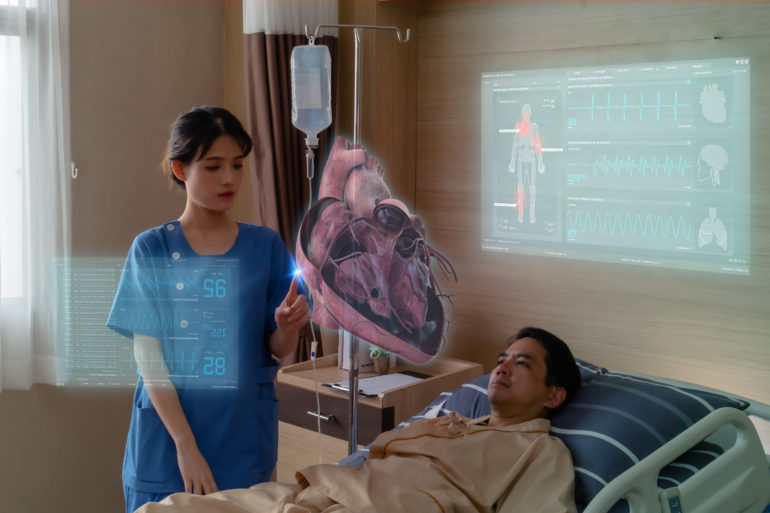To learn how we might fight the next viral pandemic, consider an engine on a commercial jet.
An engineer can recreate that engine and its every component on a computer. That computer model, called a digital twin, can be programmed to replicate every operation of a real engine, from fuel consumption to how the engine responds if a part is damaged.
Data from identical engines throughout the world can be added to the model and help engineers predict future performance — when an engine might fail, for instance, without proper maintenance. The digital twin, in a sense, improves its accuracy. It learns.
A digital twin can be created for any machine. But what about one of the most complex machines of all — the human body?
A University of Florida Health researcher is helping to lead a call to action for the medical community, arguing that digital twins of an aircraft engine, and others commonly used by industry, can teach scientists important lessons about how to combat the next great contagion.
Reinhard Laubenbacher, Ph.D., a mathematician who is a professor in the UF College of Medicine’s division of pulmonary, critical care and sleep medicine, argues in a March 12 article in the journal Science that complex human digital twins, while years in the future, are an urgent, transformational next step for medicine.
Laubenbacher said digital twins could provide scientists a dynamic template to help them rapidly design vaccines or develop therapies by modeling their impact not just on patients generally, but also for individuals with unique physiology and pre-existing medical conditions.
While simple digital twins already exist — one example is a model to predict the chances of developing blood clots during heart surgery — Laubenbacher acknowledged complex systems useful to fight a pandemic might still be years distant and will require great investment and coordination between diverse disciplines.
“We’re not quite there yet when it comes to Star Trek-type technology,” he said.
Aspects of his vision might sound like science fiction, he said. But Laubenbacher is convinced that advances in computational power and artificial intelligence make the time ripe to embark on this path.
Laubenbacher said next-level digital twins could have applications across medicine, not just in fighting pandemics. But he said the COVID-19 pandemic provides a good illustration about why scientists need to start thinking about developing these systems immediately.
“For the next 15 minutes, we have everyone’s attention with this pandemic, until the next big thing comes along,” he said. “It points to the things we need to start doing for a more well-organized response to a similar health emergency in the future.”
A complex human digital twin, Laubenbacher said, could allow doctors to forecast how a virus, or the vaccine fighting it, will impact different organs, from the lungs to the heart and brain. It could help predict how a virus will move through different populations.
It opens doors for individualized medicine, perhaps even vaccines tailored to individuals.
That digital twin of the jet engine allows engineers to predict when different components will fail without proper maintenance. If one part is redesigned, the twin can test how the engine responds. A failure on computer prevents a failure in the air.
“The idea is a compelling one,” said Laubenbacher. “You could collect data from an individual patient that account for this individual’s variation from some abstract norm. And then you use that to predict maybe an hour into their future, maybe two hours, maybe two weeks, to see how this person will respond to a particular treatment or if they’re likely to become seriously ill.”
Reinhard Laubenbacher, Ph.D., a mathematician who is a professor in the UF College of Medicine’s division of pulmonary, critical care and sleep medicineScientists have already designed computer models of individual physiological systems and viral behavior. And knowledge about aspects of viral infection is already strong, Laubenbacher said. Researchers have a good understanding, for instance, of viral replication rates and patterns, and of how the novel coronavirus infects the lining of the lungs.
“I think it is to some extent a matter of taking existing knowledge, existing computational models, and combining them,” Laubenbacher said.
Great barriers, however, remain.
“Fundamentally, one of the things we’ve learned with this current epidemic is that there are many, many things about the immune system and how it responds to pathogens that we don’t yet understand,” he said.
And there is far more individual variation in the human race, of course, that in any particular model of jet engine.
Laubenbacher is the co-lead on a National Institutes of Health working group examining multi-scale modeling of viral pandemics with the goal of creating a blueprint for what it would take to build a digital twin for viral pandemics.
“Once you get the inventory of what’s needed, then you come up with the pricetag and it could be anywhere from $50 million to $200 million,” Laubenbacher said. “That might give you a substantial product. That’s a lot of money. But on the other hand, it’s not a huge amount when you consider the potential benefit.”
The timeline is hard to know right now, he noted. The effort could take a decade or more. But it’s the kind of moonshot project that could transform medicine.
“Of course,” Laubenbacher said, “the next pandemic might just be a few years away.”
Laubenbacher is the lead author of the article. His co-authors are James P. Sluka, Ph.D., and James A. Glazier, Ph.D., who are affiliated with Indiana University Bloomington’s Luddy School of Informatics, Computing and Engineering.
Visit https://science.sciencemag.org/content/371/6534/1105 to view the Science article.
This story originally appeared on UF Health.
Check out other stories on the UF AI Initiative.

